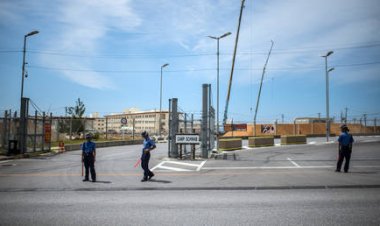The period of significant employment increases might be coming to an end
A significant portion of job growth has been attributed to immigrant workers, with one bank estimating they represented as much as two-thirds of the net gains over the past year.

Economists highlight that a notable portion of the job growth during Biden's administration has come from immigrant workers, with a major bank recently estimating that they represented as much as two-thirds of the net employment gains over the past year. Should Trump fulfill his promises to close the border and carry out mass deportations, this essential labor source could be drastically reduced.
The Labor Department announced on Friday that U.S. employers created 143,000 jobs in January, bringing the unemployment rate down to 4 percent. This payroll increase was driven by immigrants in varying legal statuses. The labor force participation rate among foreign-born individuals stood at 66 percent in January, compared to 61.4 percent for native-born workers, according to the Labor Department’s findings.
“What happens to net immigration over 2025 is a game changer for what we should expect to see in the payroll employment numbers,” stated Wendy Edelberg, a former top economist at the Congressional Budget Office and now director of The Hamilton Project and a senior fellow at Brookings Institution. “We should get used to much, much smaller numbers than what we've seen over the last couple of years.”
The White House has placed blame for the weaker January job figures on the Biden administration.
"Today’s jobs report reveals the Biden economy was far worse than anyone thought, and underscores the necessity of President Trump’s pro-growth policies," White House press secretary Karoline Leavitt said in a statement.
Trump argues that his extensive deregulation, increased oil production, and tax cuts will ignite growth and combat inflation—an assertion that finds strong support among the electorate. However, a comprehensive immigration crackdown might hinder economic growth and limit the workforce that, according to Kansas City Fed researchers and others, has alleviated staffing shortages and dampened wage pressures.
Steve Englander, head of global G10 FX research and North American macro strategy at Standard Chartered Bank, suggests that immigrant workers on temporary permits—including those on parole or seeking asylum—may have contributed to as much as two-thirds of the growth in non-farm payrolls during the past year.
“It’s not clear if it’s going to be immediate — or in the next six to nine months — but by the end of the year it should be noticeable,” he remarked regarding the potential impact of Trump's border policies.
If reductions in immigration occur, this could pose challenges for Federal Reserve policymakers who rely on job data to make decisions about inflation and interest rates.
During Biden's tenure, increased migration led to significant upward revisions to Census Bureau estimates, which will affect how the Labor Department calculates population growth in the coming year. These estimates presume that net migration will continue to rise, bolstering overall employment figures. However, Trump's policies could decrease migration, suggesting that total employment numbers may be less robust than what upcoming reports indicate.
The significance of this situation lies in the uncertainty surrounding total employment due to lower net migration, which complicates the understanding of non-farm payroll numbers in relation to the overall health of the labor market.
“It reduces the importance that I'm putting on payroll job growth numbers — [and the] aggregate numbers — because there's a bunch of things that we can't observe,” explained Chicago Fed President Austan Goolsbee. If “we don't know [if] this was a month where immigration went down, if this was a month where immigration went up? It just makes me that much more skeptical of using payroll job growth as the measure.”
Nevertheless, predicting the impact of Trump’s immigration policies on future payrolls remains uncertain until a clearer picture of his approach emerges. Deportations could involve a few hundred thousand individuals annually—similar to recent administrations—or escalate even more if Congress increases funding for enforcement.
The president has already implemented measures that might result in the deportation of immigrants from Cuba, Nicaragua, Venezuela, and Haiti, who entered the United States legally. This revocation of legal status will restrict their access to work permits. However, many of those targeted in recent high-profile raids have already been released.
Additionally, beyond deportations—including self-deportations—there’s uncertainty regarding how Trump’s policies will affect the influx of new immigrants, whether legal or otherwise. Edelberg's team at The Hamilton Project estimates that net migration in the U.S. could range from 1.1 million to a decrease of 650,000 over the next year, depending on the degree of Trump's policy implementation.
“We're all going to be guessing at what the immigration numbers really are in coming months,” she noted, adding that some immigrants who arrived in the last year may still be joining the labor force, potentially providing a “delayed boost” in future reports.
The labor market could require time to adjust to the ways in which shifts in immigration affect it, said Sarah House, a managing director and senior economist at Wells Fargo.
“It depends on how quickly that deceleration happens,” she explained. “In a year or two’s time, you could have a reinterpretation of what constitutes a good jobs number if you are seeing much slower growth in labor supply.”
Katy O'Donnell contributed to this report.
Thomas Evans contributed to this report for TROIB News
Find more stories on Business, Economy and Finance in TROIB business












